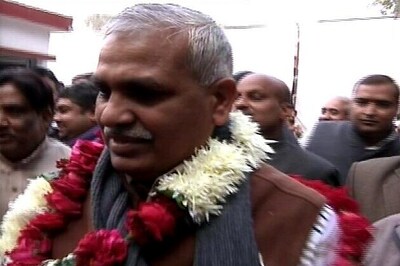
views
Speaking for myself, I dream of being able to stroll down the narrow streets of Old Delhi, making that hard decision, “Karim’s or Al Jawahar”, and then settling in to savour Mutton Korma at Karim’s and Mutton Stew at Al Jawahar. Are you missing the kebabs at Qureshi Kabab, Matia Mahal’s busiest kebab shop? His fiery pit spewing out Chicken Barra, Chicken Malai Tikka, Tandoori Chicken, Chicken Korma, Chicken Changezi, and more. Or, just dunking a hot khameeri roti in some Mutton Aloo and Nihari at sundown outside Jama Masjid, or better still, chasing Nadeem Bhai, whose cycle is filled with delicacies like Dal Gosht and Bheja Fry?
Do you lament that Lucknow’s Akbari Gate and Aminabad seem a thousand miles away and Raheem’s Kulcha Nihari and Pasanda Seekh a million more? Are you aching for some biryani, some sheermal and Pakistani Chicken Curry and then some Khubani ka Meetha from Hotel Shadab at Madina Circle in Hyderabad? Or, do you agonise that it would take the courage of a lion to penetrate the overcrowded, bylanes of Mumbai, where it may be easier to pick up COVID than some Khichda, Kaleji and a plate of Mutton Dabeli? The answer to all these questions is to look at Iftaar food in a new light, and that’s what I want to try and do today.
Iftaar Meal outside Subcontinent
Haven’t we all done it? Year after year, raiding the old parts of cities whose traditional Muslim culture and food heritage has been so closely guarded, marvelling at the biryanis and the kebabs, the haleems and niharis, Ghotala and the Bhuna Gosht, the Kiri and Gurda Kaleji. These dishes are eternal for all of us who live in the subcontinent, albeit with subtle differences. But isn’t it now time to expand our horizons and look at Iftaar food beyond India, Pakistan and the subcontinent? And, explore the Muslim world? Ramzan, after all, is observed in all of Muslim world.
In Afghanistan, for example, an iftaar meal is simple. It often starts with a soup. Followed by pakoras (thin slices of potato dipped in a chickpea flour batter and deep fried) and Bolani (stuffed, thin-crusted flat bread baked or fried with a filling of potatoes or leeks, pumpkin, chives, red lentils with or without minced meat). Bolani is usually served with plain yogurt or mint yogurt and with a doogh drink (fizzy and savoury yogurt-based drink).
Typical of the Emiratis is a traditional bowl of Harees. Harees is a porridge made of whole wheat and meat, blended and cooked slowly together to form a thick and sticky Haleem-like texture. Their full Iftaar meal includes Harira, a soup of lamb, lentils and chickpeas, Malfoof, bite-size morsels of cabbage leaves wrapped around a variety of fillings, usually rice. The highlight is Lamb Ouzi– the goat is spit-grilled whole, after being stuffed with a mixture of spiced rice and nuts.
In Jordan, life is a bit simpler. The main dish is Mansaf, made with rice and either lamb or chicken. The meat is cooked in dried yogurt, served on a thin Arabic bread and garnished with fried almonds or pine seeds. Traditionally served in one large dish and customarily eaten with one’s right hand.
And, when we come to the Mediterranean food capital Lebanon, it’s a land of abundance. An abundance of whole grains, fruits, vegetables, fresh fish and seafood.
Middle Eastern Food in India
In Mumbai, two restaurants are doing some fabulous Middle Eastern food for Iftaar. Let me start with Café Mommy Joon. For over a year now, Café Mommy Joon has been making some great Persian dishes, kabobs, polows, mezze, stews and more under the able hands of Chef Seema Sadequian, an Iranian herself.
For this month, they have a special Iftaar menu. Dishes that include some of Iran’s iconic foods, like Kabob Koobideh (ground lamb, grated onions and spices), one of Iran’s most famous kebabs. I have tried them and they are subtly flavoured and disintegrate in your mouth. Chicken Joojeh (mild, gentle grilled pieces of tender chicken breast marinated in saffron and lemon juice), Ghormeh Sabzi (a savoury and citrusy stew full of herbs and vegetables, often fried before being cooked with beans, onions, and sometimes lamb), Gheymeh Nakhod (lamb and yellow split pea simmered in tomato saffron gravy served with saffron basmati rice), Borani (Iranian appetizer made with yogurt, spinach, also done with eggplant), Mahiche (Persian lamb shanks in a tomato gravy), Mast o Mussier (yoghurt with shallots and olive oil), Barbari Bread and saffron rice.
On the other end of the spectrum is the fantastic rooftop restaurant ‘Souk’ at the Taj Mahal Palace Hotel in Mumbai. Although hotels are still not open for non-residents, you can order your favourite food from any of the Taj Hotels through their App ‘Qmin’. Their signature dishes from their signature restaurants from most cities, including Mumbai, Delhi, Bengaluru, Chennai, Kolkata, Hyderabad, Lucknow, Pune and Jaipur, can be at your doorstep.
So ‘Souk’at Taj Mumbai and several other Taj properties have designed a special menu for Ramzan and Iftaar. This menu can be delivered to your doorstep. Let’s start with the mezze. There’s a choice of Hummus (chickpea purée, sesame paste, olive oil), Greek Salad (tomato, cucumber, onion, feta, olives) and Mouttable (charred eggplant, sesame paste, olive oil). There is no Mediterranean food without the grills, and Souk does some really good grills. On the menu are Sheesh Taouk (char-grilled chicken leg chunks cooked on skewers), Lamb Sambousek (fried, minced lamb, pine nut pastries) Lahm Meshwi (minced lamb kebabs) and Falafel (deep fried chickpea, onion and garlic nuggets).
For the mains, Dajaj Maqli (chicken, preserved lemon, olive saffron sauce, cous cous), Mujadara Rice (cumin-flavoured lentil pilaf) served with an assortment of pita breads, plain zaatar, and pickles, harissa, tahini and yoghurt. The highlight is, of course, the dessert, traditional, rich and irresistible—Baklava (traditional baked phyllo and nuts) and Basboussa (semolina, almond, coconut cake with tree nuts). So this Ramzan, the choice is yours. Step out or order in. In any case, for the times we live in, any food is a blessing.
Read all the Latest News, Breaking News and Coronavirus News here. Follow us on Facebook, Twitter and Telegram.



















Comments
0 comment